Everyone you know come down with a ‘super-cold’? CDC says 15 states are suffering ‘very high’ or ‘high’ levels of respiratory illnesses, is YOURS a hotspot?
If it seems like your coworkers are calling in sick or friends are canceling their plans because they're not feeling well, you're not alone.
Millions of Americans across the country are falling ill from a range of respiratory illnesses, which are striking earlier and at higher levels than before the pandemic.
More than a dozen states are experiencing a surge of viruses, including influenza, respiratory syncytial virus (RSV) and Covid-19, with infection rates at “high” or “very high.”
The Centers for Disease Control and Prevention reports that 15 states are experiencing increased infection rates — based on the weekly percentage of visits to health care providers or hospitals involving patients complaining of fever, cough or sore throat.
South Carolina and Louisiana have been designated “Level 12,” meaning their disease rates are “very high.”
The graph above shows the percentage of emergency room visits for Covid-19, RSV and influenza
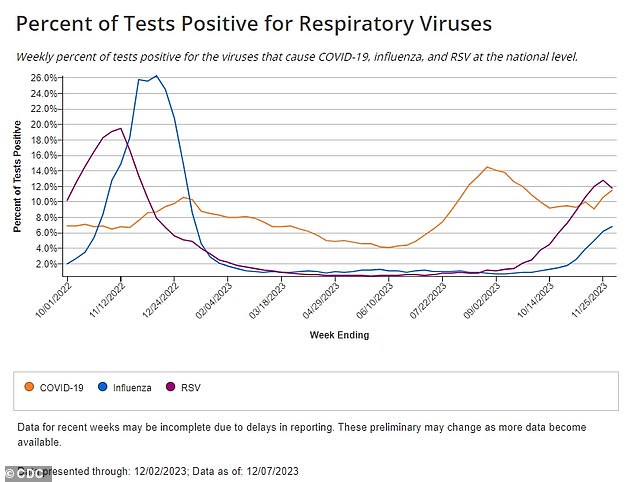
The graph above shows the percentage of tests positive for Covid-19, RSV and flu
Ranging from levels of nine to 10, a further thirteen states – including Alabama, California, Florida, Texas and New Jersey – are considered to have 'high' levels of respiratory disease.
New York State has a “low” level statewide, but New York City has been individually designated a “high” level.
Although Americans are regularly infected by a range of diseases during the winter, the levels seen this cold season are higher than pre-pandemic rates and have hit the country earlier than the usual season start.
In addition to the number of cases, the number of emergency department visits for these respiratory diseases has doubled since the end of October.
The percentage of hospital visits for the three viruses increased from a combined 2.3 percent in the week ending October 21 to 4.5 percent in the week ending December 2.
Covid figures are the highest, with 2 percent of emergency department visits attributed to the virus, followed by 1.8 percent for flu and 1 percent for RSV.
Hospital visits for flu and RSV – a virus that causes sore throat, headache, shortness of breath, wheezing and worsening cough – have more than doubled since hitting a low in late October.
However, the rate of positive tests for RSV fell to 11.8 percent in the week ending December, down from a recent high of 12.8 percent the week before.
Despite the decreased number of RSV-positive tests, the number of Covid and flu cases is still rising.
In the week ending December 2, there were 11.5 percent positive tests for Covid and 6.8 percent positive tests for the flu – an increase from 10.6 percent and 6.2 percent respectively from the week ending ended on November 25.
And the number of Covid hospital admissions has also increased steadily over the past month. In the week ending December 2, there were 22,500 hospital admissions due to the virus.
The CDC recently reported that it was tracking a new Covid variant: JN.1.
The agency estimates that the variant comprises 15 to 29 percent of Covid cases in the US as of December 8.
The agency said it is currently the fastest-growing variant in the country and its presence will continue to increase.
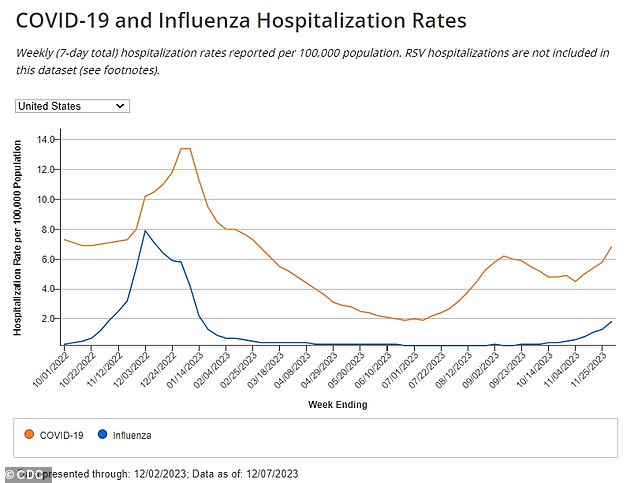
The above shows hospital admission rates for Covid-19 and the flu
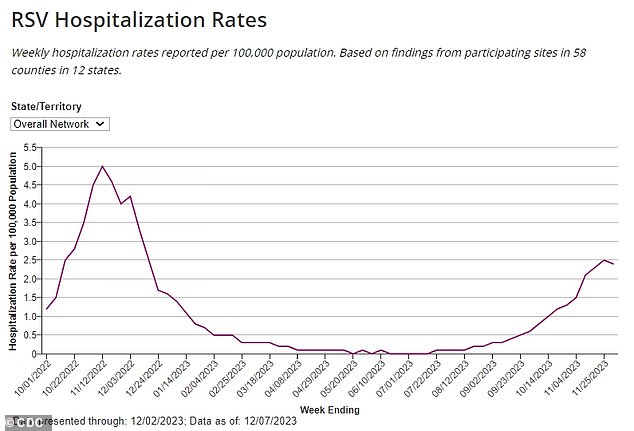
Above you see the hospitalization rates for RSV
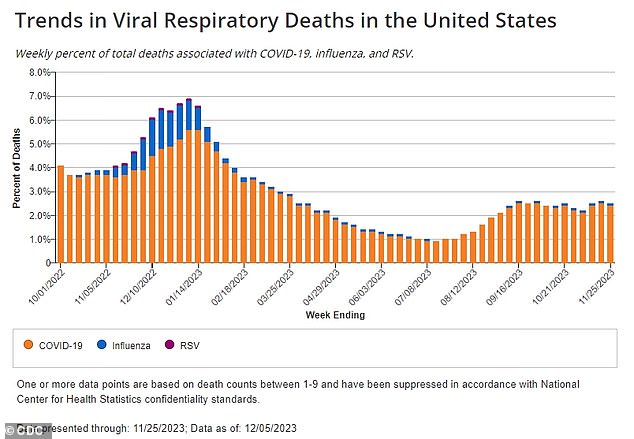
Above is the weekly percentage of deaths linked to Covid-19, the flu and RSV
JN.1 is very similar to the previous BA.2.86 variant, with only a single change that mutates in the virus's spike protein.
The new variant was first discovered in the US in September and made up just 0.1 percent of Covid cases in October.
Due to its rapid spread, the CDC believes the disease is more transmissible or better at evading the human immune system, but there is no evidence the variant poses an increased risk to humans and no evidence it is more serious than previous variants.
Additionally, Covid tests and treatments are expected to be effective against JN.1 and updated vaccines are expected to increase protection against the variant.
The emergence of the three viruses has raised concerns among health experts, who said last winter's “triple epidemic” was one of the worst virus seasons they had ever seen.
However, this year has also seen a worrying rise in cases of childhood pneumonia in Ohio and Massachusetts – also known as 'white lung syndrome' – with health experts saying it is only a matter of time before cases begin to spread to other countries . states.
Dr. Raj Rajnarayanan, an infectious disease expert in Arkansas who tracks Covid variants, warned that with so many pathogens in circulation, there could be a “syndemic” in the US – where more than three pathogens cause outbreaks at the same time .
Children and the elderly are typically hit hardest in these types of outbreaks, due to their developing and compromised immune systems, respectively.
Department of Health and Human Services data analyzed by DailyMail.com showed that 79 of 711 hospitals with pediatric wards – or 11 percent – were overcapacity in the week to November 25, the latest available.
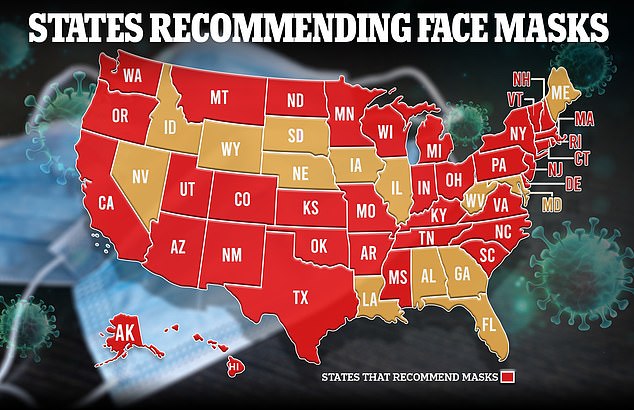
The CDC's recommendations for face coverings vary based on the level of hospitalization in a given area — and 31 states are following suit. Red states indicate those following CDC recommendations and brown states indicate those that do not recommend face masks or have limited recommendations
While this is down from 15 at the same time last year, it is still early in the season and that number is expected to rise as cases continue to rise.
Due to the increase in illnesses, CDC Director Dr. Mandy Cohen has issued a new call for Americans to mask up again this holiday season — despite mounting evidence that face coverings do not protect against respiratory viruses.
She urged people to get their latest Covid, flu and RSV vaccines, adding: 'Use extra layers of protection such as avoiding sick people, washing your hands, improving ventilation and – wearing a mask.”
However, the CDC's advice to wear masks again has been labeled “outdated” and unscientific by health experts, with some saying there is now “too much evidence” showing that masks don't work for the health agency to continue to ruthlessly recommend them.
Dr. Monica Gandhi, an infectious disease expert at the University of California, San Francisco, told DailyMail.com that the CDC has been too “slow” to keep up with the science.
She told DailyMail.com that the CDC should “re-evaluate outdated guidelines” and remove widespread masking recommendations.
